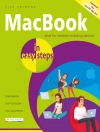Increase productivity and lower the operating cost of your business by automating crucial business processes with the Raspberry Pi. After completing this book’s projects you’ll be able to determine the best way to quickly apply automation to existing systems and processes in your retail outlet with Raspberry Pi.
You’ll start by composing ideas to transform your business, and then gain practical, accessible methods for executing them. Find real-world ways to implement tech solutions to accelerate the growth of your business, and navigate the ever-changing landscape of retail automation with this book. Then see what automation can and cannot do at the current level of technical progress for retail businesses. By comparing the efficiency of machines with manual labor, you’ll be able to assess how open-source hardware performs in lowering operating costs and identify business components that can be improved with automation.
Raspberry Pi Retail Applications features projects that are easy to dive into and will function readily in your day-to-day business right now.
What You’ll Learn
- Identify business components that can be improved with automation
- Combine the existing array of Raspberry Pi hardware options to build customized solutions
- Implement tech ideas in a practical retail environment to reduce cost and streamline your business processes
Who This Book Is For
Small and medium business owners or technology officers looking for solutions to increase efficiency, lower operating costs, and drive up profits for their retail companies with automation. Familiarity with open-source hardware and programming skills is helpful, but not necessary.
Inhaltsverzeichnis
Chapter 1: Understanding the Applications of Automation in Retail.- Chapter 2: People Counting.- Chapter 3: Vending Machine.- Chapter 4: Interactive Touch Screen Directory.- Chapter 5: Voice Interaction Drive-Through Self-Service Station.- Chapter 6: Employee Attendance Management System.- Chapter 7: Advertisement Display.- Chapter 8 Cluster for Web Application Hosting.- Chapter 9: Summary and Tips on Practical Implementation.
Über den Autor
Elaine Wu specializes in business partnerships and marketing in various tech industries, from software to embedded hardware. She is currently the marketing and partnership manager at Seeed (an open-source AIo T hardware platform) where she focuses on the global Io T solution ecosystem, making technology accessible for all. At Seeed, by aligning with partners and best hardware, she believes and strives on the path of the most reliable hardware platform, empowering everyone to achieve their digital transformation goals. She was also leading community partnerships, content marketing, new products‘ go-to-market strategies at Seeed before 2021. Elaine is also an active article contributor on a variety of industries topics, including but not limited to SBCs, microcontrollers, ML/AI, robotics, and SLAM.
Dmitry Maslov works professionally in applied machine learning and robotics. He’s spearheaded a variety of machine learning projects, both for previous employers and as a freelancer. Proficient in Python and C/C++, Dmitry has an excellent knowledge of ROS and ROS-i. He speaks four languages with professional fluency in three. Dmitry is the owner of Hardware.ai, a You Tube channel where he publishes videos on creating intelligent systems with machine learning and ROS on single-board computers.












